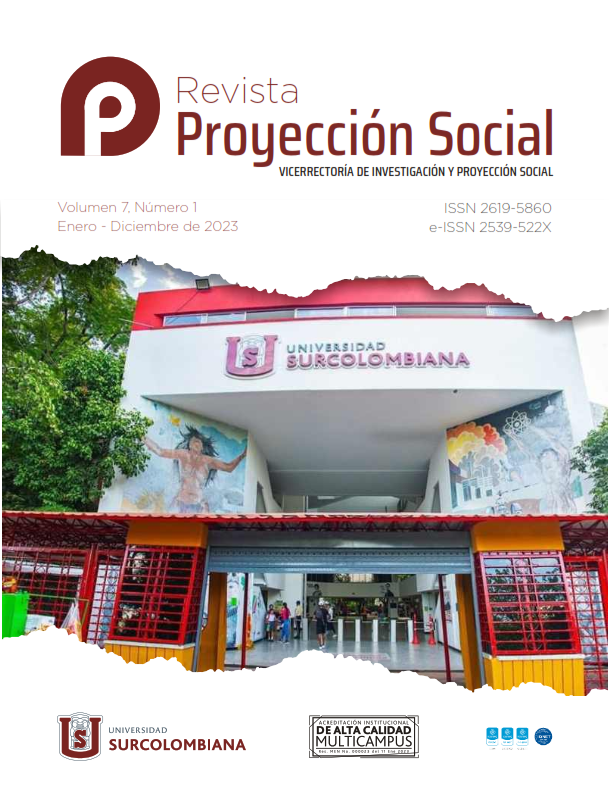Magdalena River, Threatened Source of Life
##plugins.themes.bootstrap3.article.main##
Most of the land surface is covered by water, most of which is brackish water (97.5%) and only 2.5% freshwater. Colombia is one of the countries with 2,132 Km3 of fresh water reserves in the world, whose main hydrographic sources are represented by the Magdalena River, the Cauca River, the Amazon River and the Orinoco River, which makes the country a paradise full of water resources. Due to this, the objective of this research is to carry out a bibliographic review of the deterioration of the Magdalena River in the department of Huila, since this is its birthplace. Due to its excellent geographical location, the river has been subject to overexploitation of its natural resources, with the construction of two hydroelectric power plants along the river basin, which cause damage such as the transport of sediments, displacement of wildlife, and changes in the economy of the inhabitants of the region, This is why it is important to exercise control over the uses given to the river, since it is one of the most important tributaries of the
country, with the intention of conserving the natural resources.
Downloads
##plugins.themes.bootstrap3.article.details##
Baratto, J. M. (2022). Impacto ambiental generado por la hidroeléctrica El Quimbo en Huila, Colombia. [Ensayo científico-académico de pregrado, Universidad Militar Nueva Granada]. https://repository.unimilitar.edu.co/handle/10654/44070
Barreiro, A. M. (2015). Propuesta de Modelo de Gestión Regional Sostenible para sistemas de tratamiento de aguas residuales en los municipios del Huila, ribereños al Río Magdalena [Tesis pregrado, Universidad de La Salle] Ciencia Unisalle.https://ciencia.lasalle.edu.co/ing_ambiental_sanitaria/521/
Córdoba, D. F, Vanegas, S. C. (2018). Fundamentación de las Estrategias Implementadas para Reducir los Impactos Ambientales y Sociales Generados por la Actividad MineroEnergética en la Cuenca del Rio Magdalena en el Departamento
del Huila. [Monografía posgrado, Universidad Nacional Abierta y a Distancia]. Repositorio Institucional Universidad Nacional Abierta y a Distancia. https://repository.unad.edu.co/handle/10596/24155
Cortes, A. A. (2021). Transformación de la pesca artesanal en el río magdalena, a partir de la construcción de las represas Betania
y el Quimbo, en el departamento del Huila. Relato desde las voces de los pescadores. [Tesis de maestría, Universidad
Surcolombiana]. Repositorio Institucional Usco. https://biblioteca.usco.edu.co/cgi-bin/koha/opacdetail.pl?biblionumber=46421&query_desc=au%3A%22Torres%20Silva%2C%20William%20Fernando%22
Herrera, P. A. (2018). Análisis cualitativo del impacto ambiental por vertimiento de aguas residuales en el río Magdalena, caso Aplicativo municipio de Girardot Cundinamarca [Monografía de pregrado, Universidad Piloto de Colombia Seccional Alto Magdalena]. Re-Pilo. http://repository.unipiloto.edu.co /handle/20.500.12277/5761
Laverde, L. (2016). Evaluación del impacto de los embalses por retención de sedimentos sobre la morfología del cauce del Río Magdalena mediante el análisis de tramos representativos en el comportamiento sedimentológico entre el embalse de Betania y el municipio de Regidor. [Tesis de pregrado, Universidad de La Salle]. Ciencia Unisalle. https://ciencia. lasalle.edu.co/ing_civil
Maldonado-Ocampo, J. A., Ortega-Lara, A., Usma Oviedo, J. S., Galvis Vergara, G., Villa-Navarro, F. A., Vásquez Gamboa, L., Prada-Pedreros, S., & Ardila Rodríguez, C. (2005). Peses de los Andes de Colombia (1ra ed.). Instituto de Investigación de Recursos Biológicos Alexander von Humboldt. https://wwfeu.awsassets.panda.org/downloads/peces_de_los_andes_de_colombia.pdf
Mojica, J. I., Galvis, G., Sánchez-Duarte, P., Castellanos, C., & Villa-Navarro, F. A. (2006). Peces del valle medio del río Magdalena, Colombia. Biota Colombiana, 7(1), 23-38. https://revistas.humboldt.org.co/index.php/biota/issue/view/24/58
Munar, A.M., Méndez, N.M., Vinasco, M.C., Guzmán, M.S., Cortés, C.P., Trujillo, S.A., Valbuena, O.E., Bravo, M.A., Caicedo, G.E., Herrera, J.P., Ramírez, G.A., Montealegre, W.I., Mesa, C.G., Tenorio, P.A., Florido. B.A., Carvajal, L.A., Caicedo, L.P., Núñez, M.A., Fernández, A.E., … Jiménez,
L.Y. (2022). Herramientas para la Evaluación y Gestión Integrada del Recurso Hídrico. En A. M. Munar y N. M. Méndez. Editor (Eds.), Gestión Integrada de la Cuenca Alta del Río Magdalena: Instrumentos para su Evaluación y Planificación (1a ed., pp. 12-34). Sello Editorial UNAD.
https://libros.unad.edu.co/index.php/selloeditorial/catalog/book/162



